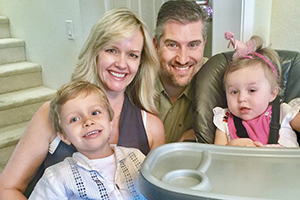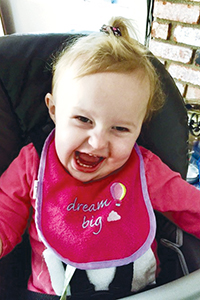TrinityKids Care staff offer loving support for children, families
By LIZ GARONE
Losing a child is every parent's worst nightmare.

Komatsu
"It's worse than losing a parent, worse than losing a spouse. It's at the very top of the list," says Dr. Glen Komatsu, the chief medical officer for Providence TrinityCare Hospice. He also is the medical director of the hospice's pediatric division, TrinityKids Care. It provides end-of-life care to infants, children and adolescents throughout Los Angeles and Orange counties, an area larger than the state of Connecticut.
TrinityKids Care is the largest pediatric hospice program in Southern California. At any given time, there are 60 to 70 patients and their families under care.
In 2017, Matt and Larissa Sonnen chose TrinityKids Care for their daughter Layla. A rare and unspecifiable brain disorder caused Layla's nervous system to malfunction and break down. She had undergone intensive treatments at three West Coast hospitals. Her care had included more than 19 teams of clinicians, according to her parents.

The Sonnen family turned to TrinityKids Care to provide in-home end-of-life care for their toddler daughter Layla, who died in July 2017. Matt and Larissa Sonnen are shown here with their children Luke and Layla celebrating Layla's second birthday. The pediatric hospice, part of Providence St. Joseph Health, serves Los Angeles and Orange counties.
Courtesy of the Sonnen family
Despite extraordinary medical interventions, her quality of life was deteriorating, and the family later wrote in an online post that Komatsu "helped us to realize that, instead of prolonging Layla's life, we were ultimately prolonging her pain."
The decision to put 2-year-old Layla in hospice care was agonizing for everyone, especially for her mother. "It felt like I was sealing Layla's fate when I heard the word 'hospice,'" she recalls. But Layla had been through so much in nearly two years as a patient and still the doctors could provide neither answers nor hope of improvement. With the gentle guidance of Komatsu and his staff, the family went from feeling like they were "giving up" on their daughter to the realization that by providing comfort and "allowing her to go" when she was ready, they were protecting her from emotional and physical pain and suffering, according to Larissa.
One of the main goals of the TrinityKids Care program is to make it possible for children to spend whatever time they have left as comfortably as possible at home with their families and to be able to die at home peacefully. This is made possible with a team of pediatric experts, which includes doctors, nurses, social workers, home health aides and chaplains. The hospice program enlists lots of volunteers who can lighten the families' loads.

Layla Sonnen
Courtesy of the Sonnen family
TrinityKids Care is currently recruiting tech-savvy volunteers to deliver virtual reality experiences to distract and amuse patients. A child need only put on a headset to take a trip to the International Space Station. So far, only a handful of children have been able to participate, according to Komatsu, as they need to be well enough to use the controls and to have the interest. He hopes to eventually expand the offerings to appeal to more children.
Family care
Margaret Severin, a clinical supervisor with TrinityKids Care, says the care team provides psychosocial support to families at an emotionally fraught time.
"Many parents remain hopeful for the miracle or just can't allow themselves to accept the inevitable, so we tread lightly," she says. "The chaplain does a lot of art therapy as many kids don't have a concept of faith, but art helps them express how they are feeling and then the chaplain can help the parents in a manner acceptable to their faith practices, if any."
Studies have shown that adult hospice patients have a higher quality of life and live longer than patients who do not get hospice care, Komatsu says, adding that for children in his hospice program, the benefits include "fewer hospitalizations, fewer ER visits, and they are more comfortable. It doesn't change the reality of their terminal disease, but it does improve their quality of life."
TrinityKids Care staff are available 24-7 to support families, but the program does not provide around-the-clock home hospice nursing. The hospice staff visit regularly and as needed, especially early on when helping families adjust to having a sick child at home. They train parents and other caregivers how to operate medical devices such as feeding pumps. They are also available by phone or text, so parents can reach out that way for medical triage and guidance.
No strangers here
For the Sonnens, having a team of people who came to them was one of the biggest stress reducers. "Before hospice, three days a week, I was piling Layla, the nurse, the pump, her medications, her stroller, everything, into my car and was driving all over Southern California for various treatments," says Larissa. "Three days a week, every week, making sure I didn't forget any medicine, making sure we had her diapers, change of clothes, blankets, extra food. It was very stressful."
Being able to stay at home was a huge relief, says Larissa. "All of a sudden, everything just started showing up at the door. That alone was just a miracle. I could just sit at home and hold her in my arms and be present with her. That was huge."
Plus, everyone who came through the door knew Layla. "They already knew her story. I didn't have to explain it. They were there 24-7 by phone or text. It didn't matter what time. I didn't have to pile Layla in the car and run to the ER at two o'clock in the morning," Larissa says.
Heartbreakingly beautiful
Layla died at home on July 8, 2017. She had turned 2 in April. Her mother held her, and her father and 4-year-old brother were next to her. Had she not been on hospice, this peaceful passing wouldn't have been possible, says Larissa. In a hospital, "there would have been machines and buzzers and beeps. We were home in our bed with her in our arms, and it was just so loving and so compassionate and beautiful in a heartbreaking way."
Layla's neurological condition left her unable to see. Her family donated her corneas, giving sight to two recipients. Two of her heart valves were used in successful transplant surgeries. The family has allowed Layla's story to be told to raise awareness of, and philanthropy for, TrinityKids Care's pediatric hospice program and for the Children's Hospital Los Angeles, where she received the bulk of her medical care.
Incalculable loss
Komatsu says clinicians can treat the physical pain of a child's terminal illness with medication, but the suffering of families requires empathy, compassion and love.
"The emotional, psychological, and spiritual pain when losing a child is just unbelievable and unimaginable for those of us who have never gone through it. What I stress to my staff and keep reminding myself is that we can't take away that pain, we can't fix that pain, but what we can do is bear witness to that pain. We can continue to show up, and we can be present in a kind and loving way to just let that child and that family know that we're going to walk beside them no matter how bad things get. It seems like not enough, but it turns out to be very therapeutic, and it's the best we can do for this unimaginable situation."